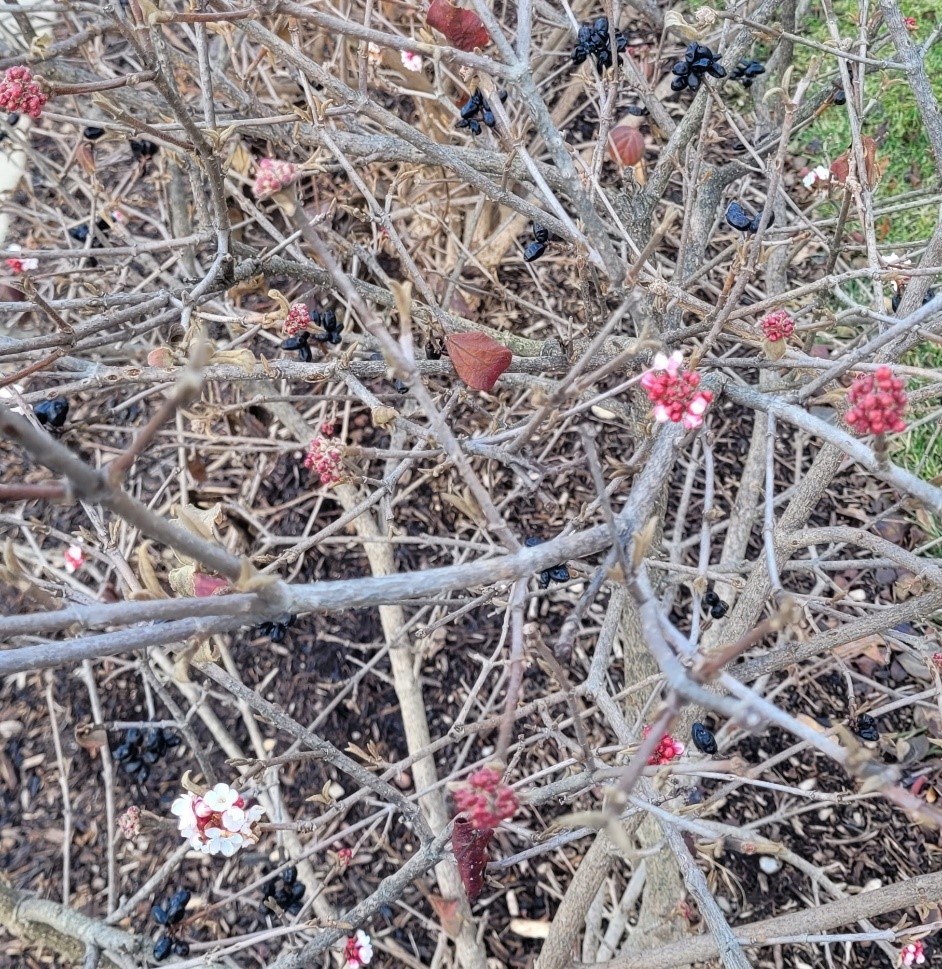Posted: December 20, 2023

A viburnum shrub that is flowering after a warm spell in late November.
By Jeff Osborne-Forest Stewardship Program Associate
As days shorten and temperatures drop in the temperate zones, many woody plants begin physiological changes to conserve energy and protect their above-ground cells from freeze injury. One very noticeable change is when deciduous trees drop their leaves. Trees also prepare for winter in more surreptitious ways. These include moving water into extracellular space and changing the chemical makeup of cellular fluid so that it freezes at a lower temperature, preventing cellular rupture during periods of extreme cold. The above-ground portions of plants generally exhibit more change and can withstand lower temperatures than the below-ground portions. Understanding a few aspects of the cold weather-induced changes can help you in a practical sense in the forest and on your homestead.
One concept that has been researched, although more heavily in orchard fruit trees than in forest trees, is chill hours. Deciduous trees begin a process of acclimatizing to winter in early autumn. This may be referred to as rest or dormancy. Many researchers break this into three periods: early-rest, winter-rest, and after-rest. During early-rest, plants prepare for colder temperatures. During the after-rest period, plants are waiting for warmer weather and longer days to spring forth and grow again. The exact physiological process of the stages of dormancy is still being researched. During winter-rest, deciduous trees in the temperate zone are accumulating “chill” hours. There have been different scales to enumerate chill hours, but generally every hour the stem spends above 35 degrees and below 45 degrees Fahrenheit equals one chill hour. Some plant species have minimum numbers of chill hours that must be reached before they can respond to warming temperatures. Ranges for chill hours required for different species and cultivars of those species have been determined by cutting twigs and then placing them in favorable bud break temperature, moisture, and light conditions. The number of chill hours is then determined from October 1 to the time the twig was cut by adding the number of hours the twig spent between 35- and 45-degrees Fahrenheit. Twigs cut from most apple trees in Pennsylvania in early November will not break bud, and few will break bud if cut from trees in December.
Currently, most of Pennsylvania has accumulated 500-700 chill hours this year. By the end of March, the state should have accumulated over 1400 chill hours, which is enough for most species with noted hour requirements. Many temperate forest trees require 1000-1500 chilling hours for normal bud-break and growth. If a tree with this requirement does not experience enough chill hours, it may have poor bud break, both vegetative and flower buds, and poor fruit production. There are apples which only require around 200 chill hours, such as granny smith, but most are only hardy from zone 6 and warmer. Practically speaking, chill hours shouldn’t be much of a concern to your established trees and shrubs, as the minimums required are often exceeded during our normal winter weather. If you are attempting to start new plants by taking cuttings and growing them in a greenhouse, you should take your cuttings closer to spring to ensure those chill hour requirements have been met.
There has also been research on the lowest temperatures roots can sustain without dying. Many roots are killed at temperatures under 20 degrees Fahrenheit. Other species’ roots can survive lower temperatures, like white spruce which can survive down to -10 degrees Fahrenheit. Temperatures low enough to kill roots are generally only experienced in the first couple inches of the soil. Root death due to cold is not a major concern with established trees but is a consideration if you have potted plants or newly planted small seedlings or smaller landscape plants.

The above picture, taken in Centre County on December 18, 2023, shows a viburnum shrub that is flowering after a warm spell in late November. These flowers will die soon and not produce fruit. This shrub also has many dormant buds which may wait till spring to open.
Many seeds dropped in autumn are also dormant through the winter. There are several types of seed dormancy: seed coat, embryo, morphological, combined, double, and secondary dormancy. These are covered in more detail in the US Forest Service publication “The Woody Plant Seed Manual.” Some of the required dormancy processes for many species are carried out over winter so they are ready to grow when the days are longer, and temperatures are warmer. The woody plant seed manual covers dormancy requirements for many common woody species, so it is a great resource if you are trying to grow trees and shrubs from seed.
There are many research articles and Extension articles covering these topics. So as the winter weather forces you to stay off the roads and stay warm inside – make like a tree and chill – you can take this time to learn more about your favorite species and how they react to and try to remain competitive despite freezing weather and darker days.
Here is a Penn State Extension video on the winter life of trees.
James C. Finley Center for Private Forests
Address
416 Forest Resources BuildingUniversity Park, PA 16802
- Email PrivateForests@psu.edu
- Office 814-863-0401
- Fax 814-865-6275
James C. Finley Center for Private Forests
Address
416 Forest Resources BuildingUniversity Park, PA 16802
- Email PrivateForests@psu.edu
- Office 814-863-0401
- Fax 814-865-6275

